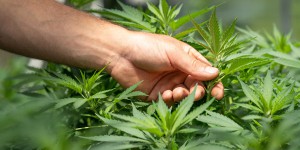By Tanja Bagar

Dr. Tanja Bagar is a microbiologist with a PhD in Biomedicine. She has gained extensive research experience in biotechnology, molecular biology and cell signaling in laboratories in Slovenia, Germany and the UK. Her focus has mainly been on the endocannabinoid system and active substances from cannabis/hemp. Her work led to the formation of the International Institute for Cannabinoids (ICANNA), where she is the CEO and chairman of the Expert Council. She is also the deputy director and head of R&D in an environmental company. She is active in the academic sphere as well. She lectures on microbiology and is the dean of the master’s program of Ecoremediations at the Faculty Alma Mater Europaea.
It is a well-known fact that growing hemp helps and nurtures the soil, even remediates it, and that it sequesters CO2 from the atmosphere with its fast growth, but recent research suggest that it can also protect us from air pollution.

Air pollution is one of the major environmental treats to our health and one that is it very hard to control or avoid. Maps of air pollution across Europe are showing alarmingly high pollution with fine particles, known as the PM particles.
PM stands for particulate matter (also called particle pollution). This term describes a mixture of solid particles and liquid droplets found in the air. Some particles, such as dust, dirt, soot, or smoke, are large or dark enough to be seen with the naked eye. Others are so small they can only be detected using an electron microscope.

Figure 1: Map of Europe showing the concentration of air PM 2,5 air pollution
(source: http://berkeleyearth.org/horrific-air-pollution-in-europe)
Particle pollution usually has a number associated with it, indicating the size of the particles. For example:
- PM10 : inhalable particles, with diameters that are generally 10 micrometers and smaller;
- PM2.5 : fine inhalable particles, with diameters that are generally 2.5 micrometers and smaller.
Ok so now we know we have these particles in the air we breathe but why is that a problem?
Studies found that when we breathe in these fine PM particles they enter the lungs where they pass readily into blood and penetrate majority of body organs, like liver, kidneys and brain. There they accumulate and over a longer period of time cause detrimental changes to the functions of the affected organs.
Researchers found evidence of this by labeling PM particles with fluorescent dyes and looking into where they land in the body of vertebrates. The results were very surprising. Namely it was expected that fine particles will be present in the lungs and maybe to some minimal extent in particular tissues. But the study clearly showed that PM particles not only accumulate in the lungs but also penetrate the pulmonary barrier very readily and travel into many other organs.

Fig. 1. Fine particle distribution in test animals. Fluorescent fine particles (indicated by arrows) were observed not only in the lung tissue but also in other organ tissues, including the brain, liver, kidneys, spleen, and testes (× 200 magnification).
This study showed clearly the presence of significant amount of PM particles in spleen, liver, brain, kidney, testis and obviously lung after exposure to PM particles twice a week for 6 weeks. If we consider urban winter periods that have the highest PM burden, extrapolation is very clear. To a large extent it is not possible to avoid this exposure for most urban inhabitants, so the question presented itself: what can we do about it?
The answer came in a surprisingly simple fashion. Different researchers attempted diverse approaches to alleviate the consequences of PM particle exposure, including aspirin, vitamin E, fish oil.... It is well known that long term exposure to PM particles is associated with acute cardiovascular and cerebrovascular events, including heart attack and stroke. It seems that the most prominent effects of the PM particles are on the blood vessel, namely vascular dysfunction, inflammation and coagulation have been clearly connected to PM particles. This can also lead to low grade systemic inflammation and differential gene expression.
A closer look only at what is happening in the lungs when PM particles are inhaled is frightening. Researchers found an increase in white blood cells, infiltration of macrophages in the lung tissue, high levels of inflammatory cytokines and change in gene expression of the cytokines. Since the PM particles are so small they can pass the pulmonary barrier easily and travel to other tissues and organs we assume similar adverse changes happen in other tissues also.
But there is good news
Of all the investigated approaches to minimize the effects a simple supplementation with omega 3 fatty acids has been shown to be the most effective. Even supplementation with omega 3 after the exposure significantly lowered the inflammation in the lungs. The best effect was achieved if the supplementation began shortly before or during the exposure to PM particles.

Fig. 2. Pulmonary inflammation induced by fine particle exposure is alleviated by omega-3 PUFA intervention. Mice were exposed to fine particulate matter for 6 weeks and then supplemented with omega-3. Pulmonary inflammation status was examined by measuring the white blood cell count in bronchoalveolar lavage (BAL) liquid, macrophage infiltration in lung tissue, key inflammatory cytokine levels and related gene expression, and phagocytic oxidative burst by in vivo imaging. (A) Total cell count in BAL. (B) Macrophage numbers in BAL. (C) Wright–Giemsa staining of bronchoalveolar lavage cells (400 ×). (D) H&E staining of lung tissue (400 ×). (E) BAL levels of inflammation-related cytokines (TNF-α, IL-6, IL-1β, and MCP-1). (F) Relative gene expression of inflammatory cytokines in lung tissue. (G) Detection of MPO activity with Luminol-R as a measure of phagocytic oxidative burst. Data are expressed as mean ± SEM, and bars with different superscript letters are significantly different (P < 0.05) according to one-way ANOVA with Tukey test; n = 8 per group.
It is not hard to imagine that PM particles hurt the lungs, but the idea of these tiny particles have a significant systemic effect on our health was harder to envision. But experiments gave a very clear message. Exposure to PM particles causes a high degree of systemic inflammation and higher oxidative stress, both of which we want to avoid. In mice they found higher circulating levels of pro-inflammatory cytokines, lower antioxidant capacity, greater level of lipid peroxidation, DNA damage and presence of endotoxins. Also here supplementation with omega 3 proved to be very beneficial alleviating significantly the systemic adverse effects of exposure to PM particles.

Fig. 3. Systemic inflammation and oxidative stress induced by fine particle exposure are alleviated by omega-3 PUFA intervention. Systemic inflammation and oxidative stress were examined by measuring plasma levels of key inflammatory cytokines and endotoxins, total antioxidant capacity, and related gene expression. (A) Plasma levels of inflammation-related cytokines (TNF-α, IL-6, IL-1β, and MCP-1). (B) Total antioxidant capacity. (C) Lipid peroxidation as measured by MDA concentration. (D) DNA damage as measured by 8-hydroxy-deoxyguanosine (8-OHdG) levels. (E) plasma lipopolysaccharide concentration. (F) Relative mRNA expression of inflammatory cytokines in spleen tissue. (G) Relative mRNA expression of antioxidant-related genes in spleen tissue. Data are expressed as mean ± SEM, and bars with different superscript letters are significantly different (P < 0.05) according to one-way ANOVA with Tukey test; n = 8 per group
These studies first of all highlight the importance of clean air in our environment. We take it for granted too many times and do not pay enough attention to its quality. Forgetting the significance of a walk in nature, among trees far form civilization.
They also give a very clear message to tissue specific and systemic dangers of exposure to polluted air. They hint that breathing in polluted air is closely related to cardiovascular diseases. Keeping in mind that these still are the leading cause of death worldwide (more people die annually from cardiovascular diseases than from any other cause) underpins furthermore the importance of air quality. But moreover these studies indicate that with a simple measure we can protect ourselves from the damage caused by PM particles.
Omega 3 essential fatty acid supplementation significantly reduced the local and systemic inflammation, thereby treating and preventing PM pollution induced health problems. Supplementing with omega 3 was effective as well as a prevention (before exposure) but also as an intervention (after exposure). There is an ongoing debate as to the best source of omega 3. Be it fish, seeds, nuts, eggs...the debate never end.
If we look at the sustainable point of view the choice is evident. If a sustainable crop that enriches the soils, sequesters carbon also provides high quality omega 3, it's a GO. Hemp seeds are rich in polyunsaturated fats, proteins, fiber, vitamins and minerals. Hemp seed oil is composed of nearly 85 percent essential fatty acids (EFAs) alone and offers the richest, most balanced natural source of EFAs. In fact the amount of alpha-linolenic and linolenic acid in 15 ml (one tablespoon) of hemp seed oil provides more than the daily EFA requirements suggested by the FDA.
In addition, hemp seed oil is lower in saturated fatty acids than other comparable oils. Hemp seed oil also exhibits the highest total phenolic content and antioxidant activity compared to all other plant-based oils (with the exception of pumpkin seed oil). Naturally occurring phenolic compounds are known to play a key role in reducing the risk of cancer, relieving systemic inflammation, acting as a powerful antioxidant and promoting free radical elimination.

Fig.4. Composition of hulled hemp seeds
While it is of utter importance to reduce air polluting, these efforts will take a long time to show their results. But during this time it is vital that we take responsibility for our health and take the measures to reduce the disease burden of air pollution. One such very practical and effective measure is by introducing hemp seeds and hemp seed oil into our diets. Either 2 tablespoons of hemp seeds or a tablespoon of hemp seed oil a day will protect us from the devastating effects of air pollution.

References:
A. Bhatnagar. Environmental cardiology: studying mechanistic links between pollution and heart disease. Circ. Res., 99 (2006), pp. 692-705
1. Abdolahi A, Georas SN, Thomas Brenna J, Cai X, Thevenet-Morrison K, Phipps RP, Block RC. The effects of aspirin and fish oil consumption on lysophosphatidylcholines and lysophosphatidic acids and their correlates with platelet aggregation in adults with diabetes mellitus. Prostaglandins, Leukot Essent Fatty Acids (PLEFA) 2014;90:61–68.
2. Antithrombotic Trialists' Collaboration. Collaborative meta-analysis of randomised trials of antiplatelet therapy for prevention of death, myocardial infarction, and stroke in high risk patients. Br Med J. 2002;324:71–86.
B. Ostro, J. Hu, D. Goldberg, P. Reynolds, A. Hertz, L. Bernstein, et al. Associations of mortality with long-term exposures to fine and ultrafine particles, species and sources: results from the California Teachers Study Cohort. Environ. Health Perspect., 123 (2015), pp. 549-556
3. Bautista LE, Vera LM. Antihypertensive effects of aspirin: what is the evidence? Curr Hyperten Rep. 2010;12:282–289.
4. Becerra AZ, Georas S, Brenna JT, Hopke PK, Kane C, Chalupa D, Frampton MW, Block R, Rich DQ. Increases in ambient particulate matter air pollution, acute changes in platelet function, and effect modification by aspirin and omega-3 fatty acids: A panel study. J Toxicol Environ Health A. 2016;79(6):287-98. doi: 10.1080/15287394.2016.1157539. Epub 2016 Mar 30.
5. Beckerman BS, Jerrett M, Finkelstein M, Kanaroglou P, Brook JR, Arain MA, Sears MR, Stieb D, Balmes J, Chapman K. The association between chronic exposure to traffic-related air pollution and ischemic heart disease. J Toxicol Environ Health A. 2012;75(7):402–411.
6. Bind M-A, Baccarelli A, Zanobetti A, Tarantini L, Suh H, Vokonas P, Schwartz J. Air pollution and markers of coagulation, inflammation, and endothelial function: associations and epigene-environment interactions in an elderly cohort. Epidemiology. 2012;23:332–340.
7. Block RC, Abdolahi A, Smith B, Meednu N, Thevenet-Morrison K, Cai X, Cui H, Mousa S, Brenna JT, Georas S. Effects of low-dose aspirin and fish oil on platelet function and NF-kappaB in adults with diabetes mellitus. Prostaglandins, Leukot Essent Fatty Acids (PLEFA) 2013;89:9-18.
8. Block RC, Abdolahi A, Tu X, Georas SN, Brenna JT, Phipps RP, Lawrence P, Mousa SA. The effects of aspirin on platelet function and lysophosphatidic acids depend on plasma concentrations of EPA and DHA. Prostaglandins, Leukot Essent Fatty Acids (PLEFA) 2015;96:17–24.
9. Environ. Health Perspect., 116 (2008), pp. 1449-1455
10. H. Kan, B. Chen, C. Hong. Health impact of outdoor air pollution in China: current knowledge and future research needs. Environ. Health Perspect., 117 (2009), p. A187
11. K.L. Ebi, G. McGregor. Climate change, tropospheric ozone and particulate matter, and health impacts
12. Li XY, Hao L, Liu YH, Chen CY, Pai VJ, Kang JX. Protection against fine particle-induced pulmonary and systemic inflammation by omega-3 polyunsaturated fatty acids. Biochim Biophys Acta. 2017 Mar;1861(3):577-584. doi: 10.1016/j.bbagen.2016.12.018. Epub 2016 Dec 21.
13. M. Brauer, M. Amann, R.T. Burnett, A. Cohen, F. Dentener, M. Ezzati, et al. Exposure assessment for estimation of the global burden of disease attributable to outdoor air pollution. Environ. Sci. Technol., 46 (2012), pp. 652-660
14. M.M. Nakhlé, W. Farah, N. Ziadé, M. Abboud, D. Salameh, I. Annesi-Maesano. Short-term relationships between emergency hospital admissions for respiratory and cardiovascular diseases and fine particulate air pollution in Beirut, Lebanon. Environ. Monit. Assess., 187 (4409) (2015)
15. Pope CA 3rd, Bhatnagar A, McCracken JP, Abplanalp W, Conklin DJ, O'Toole T. Exposure to Fine Particulate Air Pollution Is Associated With Endothelial Injury and Systemic Inflammation. Circ Res. 2016 Nov 11;119(11):1204-1214. doi: 10.1161/CIRCRESAHA.116.309279. Epub 2016 Oct 25.
16. R.D. Brook, B. Franklin, W. Cascio, Y. Hong, G. Howard, M. Lipsett, et al. Air pollution and cardiovascular disease: a statement for healthcare professionals from the Expert Panel on Population and Prevention Science of the American Heart Association Circulation, 109 (2004), pp. 2655-2671
17. Tong H, Rappold AG, Diaz-Sanchez D, Steck SE, Berntsen J, Cascio WE, Devlin RB, Samet JM. Omega-3 fatty acid supplementation appears to attenuate particulate air pollution-induced cardiac effects and lipid changes in healthy middle-aged adults. Environ Health Perspect. 2012 Jul;120(7):952-7. doi: 10.1289/ehp.1104472. Epub 2012 Apr 19.


